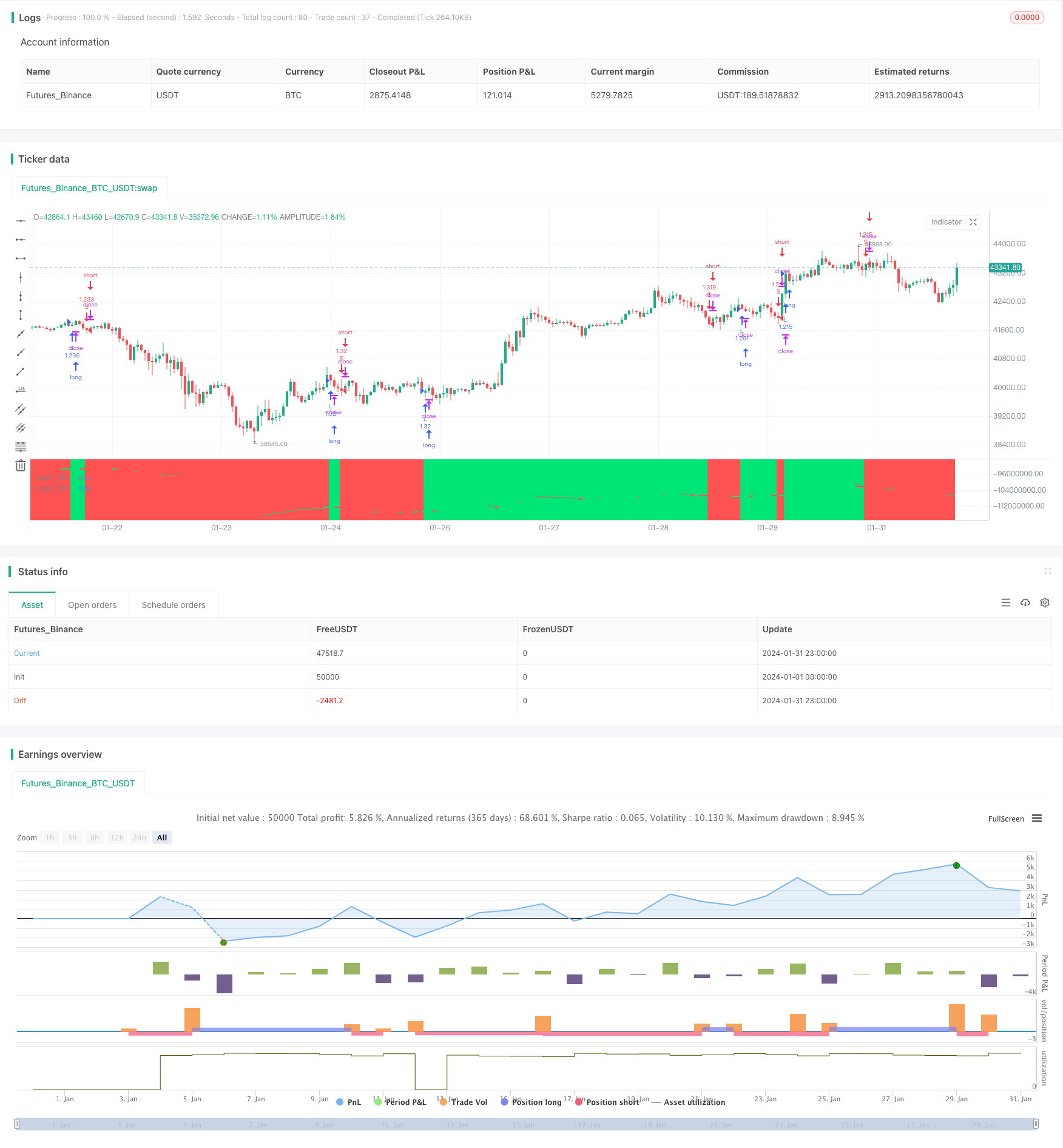
概述
该策略采用双EMA均线跨度来判断OBV指标的多空趋势,根据趋势方向进行长短做法。其中,OBV指标可以更清晰地反映出价格和成交量的关系,判断市场参与者的意愿,因此可以用于捕捉市场趋势。该策略结合移动平均线的指标平滑处理,可以有效滤除市场噪音,捕捉主要趋势。
策略原理
该策略主要基于OBV指标是否处于上升趋势来判断多头入场时机。具体来说,是计算OBV的6日EMA和24日EMA,当6日EMA上穿24日EMA时产生多头信号。同理,当6日EMA下穿24日EMA时,产生空头信号。此外,策略还设置了3%的止损。
该策略判断趋势的关键在于OBV指标。OBV指标体现大资金的集合性意愿,可以有效反映市场参与者的态度。结合移动平均线处理,可以滤除部分噪声,使得信号更加清晰可靠。策略采用快速EMA线和慢速EMA线构建交易信号,可以平滑价格数据,同时也能较敏感地捕捉趋势变化。
优势分析
该策略具有以下几个优势:
基于成交量的OBV指标可以清晰判断市场参与者意愿,信号较为可靠。
双EMA均线处理可以滤除部分噪音,使得信号更加清晰。
采用快慢EMA线组合可以兼顾平滑价格和捕捉趋势变化。
策略操作简单,容易实施。
风险分析
该策略也存在一些风险:
OBV指标在某些时候会发出错误信号,此时策略可能亏损。
在剧烈行情中,EMA线处理有滞后,可能错过最优入场点。
固定的止损设置可能过于死板,无法适应市场的变化。
对策:
结合其他指标进行确认,避免错误信号。
优化参数设置,使EMA线更灵敏。
设置动态止损。
优化方向
该策略可以从以下几个方向进行优化:
优化EMA参数组合,找到更匹配的均线参数。
增加其他指标进行信号确认,如MACD、RSI等,提高信号准确率。
设置动态止损,能够根据市场波动实时调整止损点。
进行参数组合优化,找到最佳参数组合。
总结
该策略整体来说是一种较为简单可靠的趋势跟踪策略。它结合OBV指标和双EMA均线实现了对趋势的判断。优点是操作简单,信号清晰,能够有效跟踪趋势;缺点是可能出现错误信号,且EMA线处理有滞后。通过结合其他指标进行优化,可以获得更好的效果。
/*backtest
start: 2024-01-01 00:00:00
end: 2024-01-31 23:59:59
period: 1h
basePeriod: 15m
exchanges: [{"eid":"Futures_Binance","currency":"BTC_USDT"}]
*/
//@version=4
strategy("OBV EMA X BF 🚀", overlay=false, initial_capital=10000, default_qty_type=strategy.percent_of_equity, default_qty_value=100, commission_type=strategy.commission.percent, commission_value=0.0)
/////////////// Time Frame ///////////////
testStartYear = input(2017, "Backtest Start Year")
testStartMonth = input(1, "Backtest Start Month")
testStartDay = input(1, "Backtest Start Day")
testPeriodStart = timestamp(testStartYear,testStartMonth,testStartDay, 0, 0)
testStopYear = input(2019, "Backtest Stop Year")
testStopMonth = input(12, "Backtest Stop Month")
testStopDay = input(31, "Backtest Stop Day")
testPeriodStop = timestamp(testStopYear,testStopMonth,testStopDay, 0, 0)
testPeriod() => true
/////////////// OBV ///////////////
src = close
atr = atr(input(title="ATR Period", defval=3, minval=1))
atrmult = input(title="ATR Mult", defval=1, minval=0)
obv = cum(change(src) > 0 ? volume * (volume / atr) : change(src) < 0 ? -volume * (volume / atr) : 0 * volume / atr)
e1 = ema(obv, input(24))
e2 = ema(obv, input(6))
/////////////// Strategy ///////////////
long = crossover(e2, e1)
short = crossunder(e2, e1)
last_long = 0.0
last_short = 0.0
last_long := long ? time : nz(last_long[1])
last_short := short ? time : nz(last_short[1])
long_signal = crossover(last_long, last_short)
short_signal = crossover(last_short, last_long)
last_open_long_signal = 0.0
last_open_short_signal = 0.0
last_open_long_signal := long_signal ? open : nz(last_open_long_signal[1])
last_open_short_signal := short_signal ? open : nz(last_open_short_signal[1])
last_long_signal = 0.0
last_short_signal = 0.0
last_long_signal := long_signal ? time : nz(last_long_signal[1])
last_short_signal := short_signal ? time : nz(last_short_signal[1])
in_long_signal = last_long_signal > last_short_signal
in_short_signal = last_short_signal > last_long_signal
last_high = 0.0
last_low = 0.0
last_high := not in_long_signal ? na : in_long_signal and (na(last_high[1]) or high > nz(last_high[1])) ? high : nz(last_high[1])
last_low := not in_short_signal ? na : in_short_signal and (na(last_low[1]) or low < nz(last_low[1])) ? low : nz(last_low[1])
since_longEntry = barssince(last_open_long_signal != last_open_long_signal[1])
since_shortEntry = barssince(last_open_short_signal != last_open_short_signal[1])
//////////////// Stop loss ///////////////
sl_inp = input(3.0, title='Stop Loss %') / 100
tp_inp = input(5000.0, title='Take Profit %') / 100
take_level_l = strategy.position_avg_price * (1 + tp_inp)
take_level_s = strategy.position_avg_price * (1 - tp_inp)
slLong = in_long_signal ? strategy.position_avg_price * (1 - sl_inp) : na
slShort = strategy.position_avg_price * (1 + sl_inp)
long_sl = in_long_signal ? slLong : na
short_sl = in_short_signal ? slShort : na
/////////////// Execution ///////////////
if testPeriod()
strategy.entry("L", strategy.long, when=long)
strategy.entry("S", strategy.short, when=short)
strategy.exit("L SL", "L", stop=long_sl, when=since_longEntry > 0)
strategy.exit("S SL", "S", stop=short_sl, when=since_shortEntry > 0)
/////////////// Plotting ///////////////
plot(e1, color = e1 > e1[1] ? color.lime : e1 < e1[1] ? color.red : color.white, linewidth = 2, offset = 0)
plot(e2, color = e2 > e2[1] ? color.lime : e2 < e2[1] ? color.red : color.white, linewidth = 1)
bgcolor(strategy.position_size > 0 ? color.lime : strategy.position_size < 0 ? color.red : color.white, transp=90)
bgcolor(long_signal ? color.lime : short_signal ? color.red : na, transp=60)